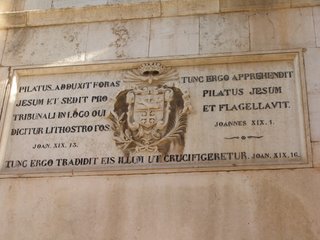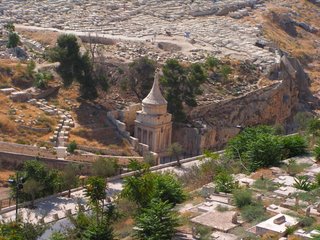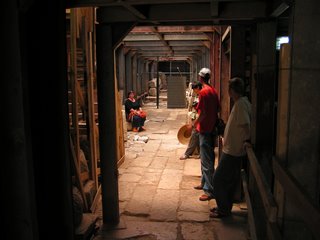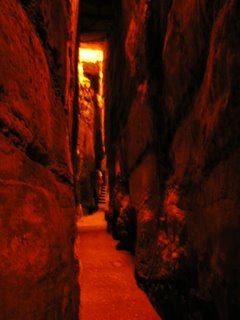Walking About the City
I went to the Old City on Monday to meet some friends and explore.
 I arrived early in the day so the city was relatively empty. Jaffa Road (Yafo, one of the main streets of the new city of Jerusalem and so named because it connect the Old City toward the direction of the port city of Joppa) is usually very crowded with car traffic and pedestrians.
I arrived early in the day so the city was relatively empty. Jaffa Road (Yafo, one of the main streets of the new city of Jerusalem and so named because it connect the Old City toward the direction of the port city of Joppa) is usually very crowded with car traffic and pedestrians.  I decided it would be safe to go through Damascus gate (one of the 10 gates to the Old City--depending on who's counting, since half of them no longer serve as entrances to the city--on the North side of the Old city). and walk around in the empty muslim quarter.
I decided it would be safe to go through Damascus gate (one of the 10 gates to the Old City--depending on who's counting, since half of them no longer serve as entrances to the city--on the North side of the Old city). and walk around in the empty muslim quarter. This sign is above the entrance to what is held to be the palace of Pilate where Jesus was tried before His crucifixion. Maybe you can make out the reference to John 19:16 and look it up. This location is the second stop along the Via Dolorosa, path to the cross.
This sign is above the entrance to what is held to be the palace of Pilate where Jesus was tried before His crucifixion. Maybe you can make out the reference to John 19:16 and look it up. This location is the second stop along the Via Dolorosa, path to the cross.  U.N. car parked in Eastern Jerusalem.
U.N. car parked in Eastern Jerusalem. El-Wad Rd. (most of the street signs in the Old City look like this...the trouble is most of them are covered up by 10 shekel t-shirts, or Israel sandals). El-Wad road runs North and South, connecting Damascus gate, on the North end, with the Western Wall Kotel on the south end. El-Wad is Arabic for "The Valley" and also marks the position of the Tyropean Valley (Valley of the Cheesemakers) which divided the 1st century city into upper and lower city (The west being significantly elevated over the Eastern side of the city).
El-Wad Rd. (most of the street signs in the Old City look like this...the trouble is most of them are covered up by 10 shekel t-shirts, or Israel sandals). El-Wad road runs North and South, connecting Damascus gate, on the North end, with the Western Wall Kotel on the south end. El-Wad is Arabic for "The Valley" and also marks the position of the Tyropean Valley (Valley of the Cheesemakers) which divided the 1st century city into upper and lower city (The west being significantly elevated over the Eastern side of the city). I took this picture from the ramped entrance to the temple mount. By about 9:00, the Western Wall was packed with visitors.
I took this picture from the ramped entrance to the temple mount. By about 9:00, the Western Wall was packed with visitors. This tunnel, accessed from the men's side of the partition to the Western Wall, is the visible remanants of Wilson's arch (named after Captain Charles Wilson, who excavated Jerusalem over a hundred years ago). The arch was once a support for a causeway entrance to the temple mount.
This tunnel, accessed from the men's side of the partition to the Western Wall, is the visible remanants of Wilson's arch (named after Captain Charles Wilson, who excavated Jerusalem over a hundred years ago). The arch was once a support for a causeway entrance to the temple mount. Absalom's Pillar. Located in the Kidron Valley where are many tombs.
Absalom's Pillar. Located in the Kidron Valley where are many tombs. Near the excavations of the New Testament pool of Siloam, they have uncovered an ancient road as well.
Near the excavations of the New Testament pool of Siloam, they have uncovered an ancient road as well. This is the largest visible stone used in the temple mount structure. I am standing at the beginning of it and my friend Ben (in the red shirt) stands at the end. They approximate that the stone ways nearly 600 tons.
This is the largest visible stone used in the temple mount structure. I am standing at the beginning of it and my friend Ben (in the red shirt) stands at the end. They approximate that the stone ways nearly 600 tons. Inside Mount Moriah.
Inside Mount Moriah.


0 Comments:
Post a Comment
<< Home